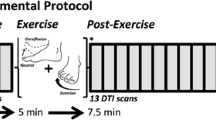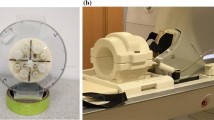Abstract
The goal of this study was to assess the changes of water diffusion during contraction and elongation of calf muscles using diffusion tensor (DT) MRI in normal volunteers. Twenty volunteers (mean age, 29 ± 4 years) underwent DT MRI examination of the right calf. Echo planar imaging sequence was performed at rest, during dorsal flexion and during plantar flexion. The three eigenvalues (λ1, λ2, and λ3), apparent diffusion coefficient (ADC) and fractional anisotropy (FA) of the diffusion tensor were calculated for medial gastrocnemius (mGM) and tibialis anterior (TA). A fiber tractography was performed on both muscles. Non-parametric Wilcoxon and Mann Whitney tests were used for statistical evaluation. At rest, λ1, λ2 and ADC of mGM were higher than their counterparts of TA (P < 0.01). During dorsal flexion, the three eigenvalues and ADC of TA significantly increased (P < 0.05) as their counterparts of mGM slightly decreased (P=NS). Opposite variations were detected during plantar flexion of the foot. Visual analysis evidenced a relationship between 3D representations of MRI fibers and physiological state of muscles. Contraction of calf muscles produces changes in DT parameters, which are related to the physiological state of the muscle.





Similar content being viewed by others
References
Basser PJ, Jones DK (2002) Diffusion-tensor MRI: theory, experimental design and data analysis-a technical review. NMR Biomed 15:456–467
Mattiello J, Basser PJ, Le Bihan D (1997) The b matrix in diffusion tensor echo-planar imaging. Magn Reson Med 37:292–300
Damon BM, Ding Z, Anderson AW, Freyer AS, Gore JC (2002) Validation of diffusion tensor MRI-based muscle fiber tracking. Magn Reson Med 48:97–104
Heemskerk AM, Strijkers GJ, Vilanova A, Drost MR, Nicolay K (2005) Determination of mouse skeletal muscle architecture using three-dimensional diffusion tensor imaging. Magn Reson Med 53:1333–1340
Sinha U, Yao L (2002) In vivo diffusion tensor imaging of human calf muscle. J Magn Reson Imaging 15:87–95
van Doorn A, Bovendeerd PH, Nicolay K, Drost MR, Janssen JD (1996) Determination of muscle fibre orientation using diffusion-weighted MRI. Eur J Morphol 34:5–10
Galban CJ, Maderwald S, Uffmann K, de Greiff A, Ladd ME (2004) Diffusive sensitivity to muscle architecture: a magnetic resonance diffusion tensor imaging study of the human calf. Eur J Appl Physiol 93:253–262
Tseng WY, Wedeen VJ, Reese TG, Smith RN, Halpern EF (2003) Diffusion tensor MRI of myocardial fibers and sheets: correspondence with visible cut-face texture. J Magn Reson Imaging 17:31–42
Morvan D, Leroy-Willig A (1995) Simultaneous measurements of diffusion and transverse relaxation in exercising skeletal muscle. Magn Reson Imaging 13:943–948
Nygren AT, Kaijser L (2002) Water exchange induced by unilateral exercise in active and inactive skeletal muscles. J Appl Physiol 93:1716–1722
Van Donkelaar CC, Kretzers LJ, Bovendeerd PH, Lataster LM, Nicolay K, Janssen JD et al (1999) Diffusion tensor imaging in biomechanical studies of skeletal muscle function. J Anat 194(Pt 1):79–88
Basser PJ, Pajevic S, Pierpaoli C, Duda J, Aldroubi A (2000) In vivo fiber tractography using DT-MRI data. Magn Reson Med 44:625–632
Mori S, van Zijl PC (2002) Fiber tracking: principles and strategies-a technical review. NMR Biomed 15:468–480
Galban CJ, Maderwald S, Uffmann K, Ladd ME (2005) A diffusion tensor imaging analysis of gender differences in water diffusivity within human skeletal muscle. NMR Biomed 18:489–498
Heemskerk AM, Strijkers GJ, Drost MR, van Bochove GS, Nicolay K (2007) Skeletal muscle degeneration and regeneration after femoral artery ligation in mice: monitoring with diffusion MR imaging. Radiology 243:413–421
Steidle G, Schick F (2006) Echoplanar diffusion tensor imaging of the lower leg musculature using eddy current nulled stimulated echo preparation. Magn Reson Med 55:541–548
Zaraiskaya T, Kumbhare D, Noseworthy MD (2006) Diffusion tensor imaging in evaluation of human skeletal muscle injury. J Magn Reson Imaging 24:402–408
Staron RS, Kraemer WJ, Hikida RS, Fry AC, Murray JD, Campos GE (1999) Fiber type composition of four hindlimb muscles of adult Fisher 344 rats. Histochem Cell Biol 111:117–123
Fitts RH, McDonald KS, Schluter JM (1991) The determinants of skeletal muscle force and power: their adaptability with changes in activity pattern. J Biomech 24(Suppl 1):111–122
Jarvinen TA, Jozsa L, Kannus P, Jarvinen TL, Jarvinen M (2002) Organization and distribution of intramuscular connective tissue in normal and immobilized skeletal muscles. An immunohistochemical, polarization and scanning electron microscopic study. J Muscle Res Cell Motil 23:245–254
Gallagher D, Heymsfield SB (1998) Muscle distribution: variations with body weight, gender, and age. Appl Radiat Isot 49:733–734
Janssen I, Heymsfield SB, Wang ZM, Ross R (2000) Skeletal muscle mass and distribution in 468 men and women aged 18–88 years. J Appl Physiol 89:81–88
Author information
Authors and Affiliations
Corresponding author
Rights and permissions
About this article
Cite this article
Deux, J.F., Malzy, P., Paragios, N. et al. Assessment of calf muscle contraction by diffusion tensor imaging. Eur Radiol 18, 2303–2310 (2008). https://doi.org/10.1007/s00330-008-1012-z
Received:
Revised:
Accepted:
Published:
Issue Date:
DOI: https://doi.org/10.1007/s00330-008-1012-z




